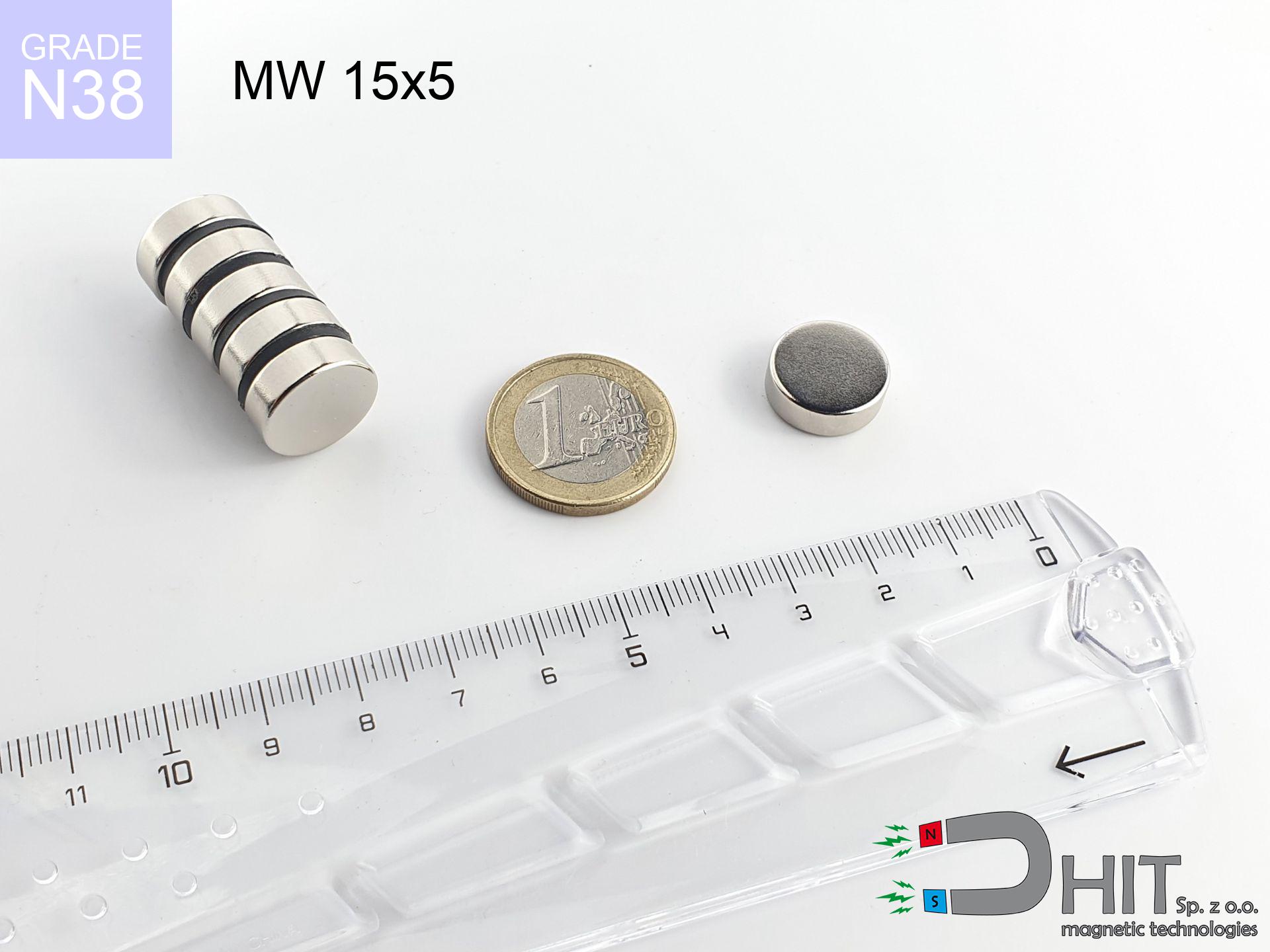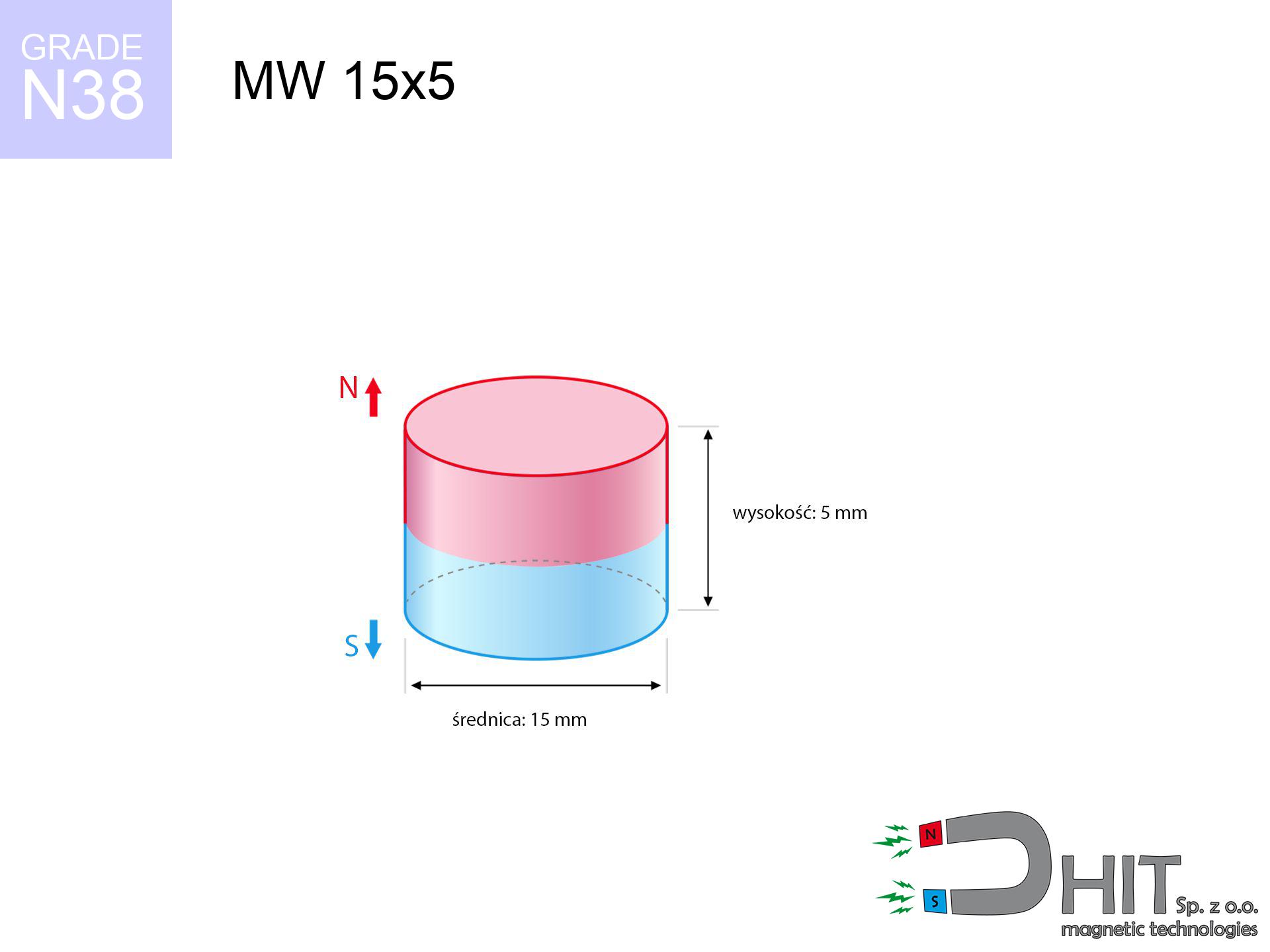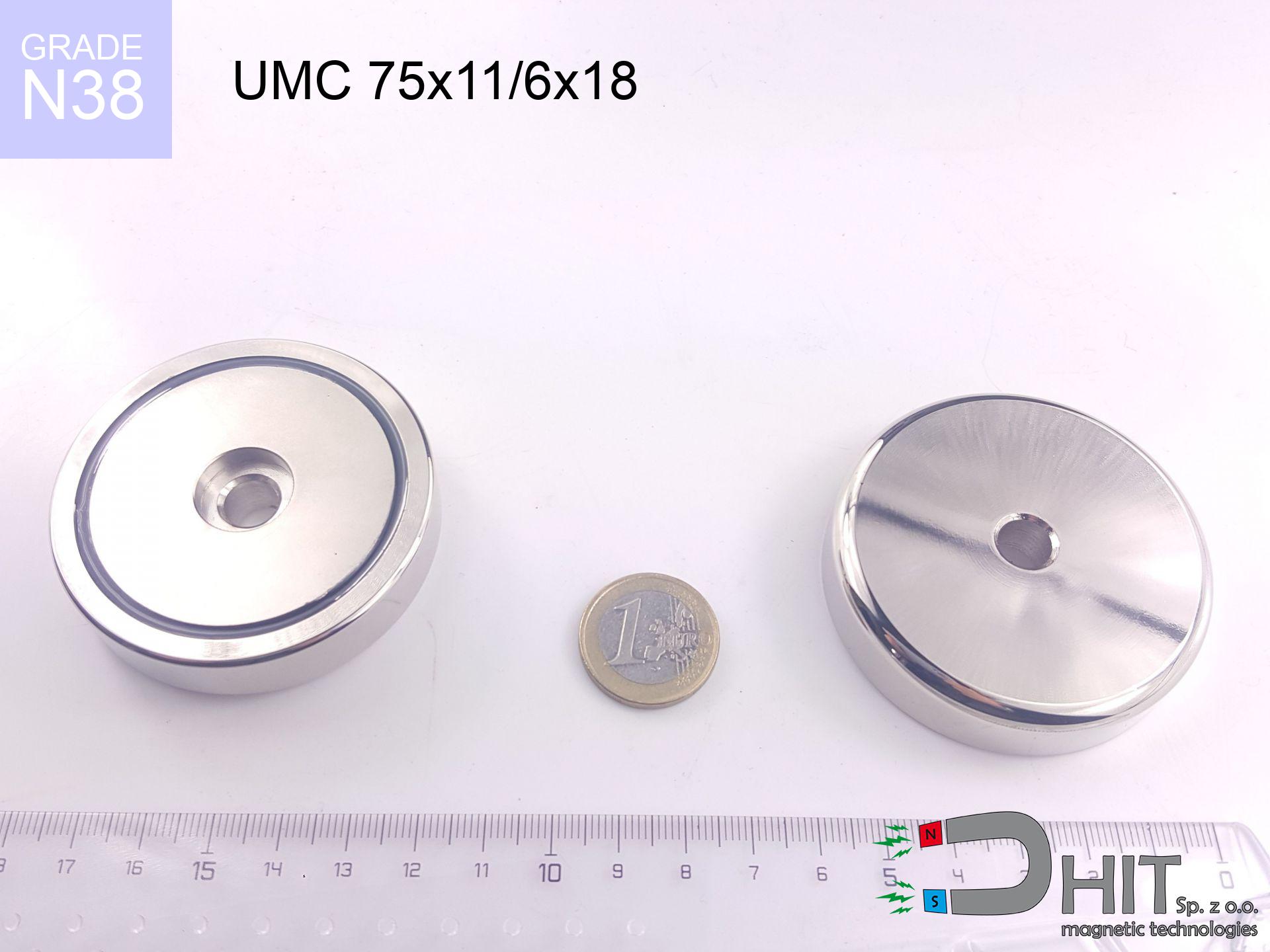MW 15x5 / N38 - cylindrical magnet
cylindrical magnet
Catalog no 010031
GTIN/EAN: 5906301810308
Diameter Ø
15 mm [±0,1 mm]
Height
5 mm [±0,1 mm]
Weight
6.63 g
Magnetization Direction
↑ axial
Load capacity
5.39 kg / 52.83 N
Magnetic Induction
343.70 mT / 3437 Gs
Coating
[NiCuNi] Nickel
3.20 ZŁ with VAT / pcs + price for transport
2.60 ZŁ net + 23% VAT / pcs
bulk discounts:
Need more?
Call us
+48 22 499 98 98
or contact us using
inquiry form
the contact form page.
Lifting power as well as structure of a neodymium magnet can be verified with our
power calculator.
Orders placed before 14:00 will be shipped the same business day.
Technical - MW 15x5 / N38 - cylindrical magnet
Specification / characteristics - MW 15x5 / N38 - cylindrical magnet
| properties | values |
|---|---|
| Cat. no. | 010031 |
| GTIN/EAN | 5906301810308 |
| Production/Distribution | Dhit sp. z o.o. |
| Country of origin | Poland / China / Germany |
| Customs code | 85059029 |
| Diameter Ø | 15 mm [±0,1 mm] |
| Height | 5 mm [±0,1 mm] |
| Weight | 6.63 g |
| Magnetization Direction | ↑ axial |
| Load capacity ~ ? | 5.39 kg / 52.83 N |
| Magnetic Induction ~ ? | 343.70 mT / 3437 Gs |
| Coating | [NiCuNi] Nickel |
| Manufacturing Tolerance | ±0.1 mm |
Magnetic properties of material N38
| properties | values | units |
|---|---|---|
| remenance Br [min. - max.] ? | 12.2-12.6 | kGs |
| remenance Br [min. - max.] ? | 1220-1260 | mT |
| coercivity bHc ? | 10.8-11.5 | kOe |
| coercivity bHc ? | 860-915 | kA/m |
| actual internal force iHc | ≥ 12 | kOe |
| actual internal force iHc | ≥ 955 | kA/m |
| energy density [min. - max.] ? | 36-38 | BH max MGOe |
| energy density [min. - max.] ? | 287-303 | BH max KJ/m |
| max. temperature ? | ≤ 80 | °C |
Physical properties of sintered neodymium magnets Nd2Fe14B at 20°C
| properties | values | units |
|---|---|---|
| Vickers hardness | ≥550 | Hv |
| Density | ≥7.4 | g/cm3 |
| Curie Temperature TC | 312 - 380 | °C |
| Curie Temperature TF | 593 - 716 | °F |
| Specific resistance | 150 | μΩ⋅cm |
| Bending strength | 250 | MPa |
| Compressive strength | 1000~1100 | MPa |
| Thermal expansion parallel (∥) to orientation (M) | (3-4) x 10-6 | °C-1 |
| Thermal expansion perpendicular (⊥) to orientation (M) | -(1-3) x 10-6 | °C-1 |
| Young's modulus | 1.7 x 104 | kg/mm² |
Technical analysis of the magnet - technical parameters
The following information constitute the result of a mathematical analysis. Results were calculated on algorithms for the class Nd2Fe14B. Real-world parameters might slightly differ. Use these data as a reference point during assembly planning.
Table 1: Static pull force (pull vs distance) - characteristics
MW 15x5 / N38
| Distance (mm) | Induction (Gauss) / mT | Pull Force (kg/lbs/g/N) | Risk Status |
|---|---|---|---|
| 0 mm |
3436 Gs
343.6 mT
|
5.39 kg / 11.88 pounds
5390.0 g / 52.9 N
|
strong |
| 1 mm |
3054 Gs
305.4 mT
|
4.26 kg / 9.39 pounds
4258.2 g / 41.8 N
|
strong |
| 2 mm |
2633 Gs
263.3 mT
|
3.17 kg / 6.98 pounds
3165.4 g / 31.1 N
|
strong |
| 3 mm |
2221 Gs
222.1 mT
|
2.25 kg / 4.96 pounds
2251.5 g / 22.1 N
|
strong |
| 5 mm |
1521 Gs
152.1 mT
|
1.06 kg / 2.33 pounds
1056.2 g / 10.4 N
|
weak grip |
| 10 mm |
585 Gs
58.5 mT
|
0.16 kg / 0.35 pounds
156.5 g / 1.5 N
|
weak grip |
| 15 mm |
260 Gs
26.0 mT
|
0.03 kg / 0.07 pounds
30.8 g / 0.3 N
|
weak grip |
| 20 mm |
133 Gs
13.3 mT
|
0.01 kg / 0.02 pounds
8.1 g / 0.1 N
|
weak grip |
| 30 mm |
47 Gs
4.7 mT
|
0.00 kg / 0.00 pounds
1.0 g / 0.0 N
|
weak grip |
| 50 mm |
12 Gs
1.2 mT
|
0.00 kg / 0.00 pounds
0.1 g / 0.0 N
|
weak grip |
Table 2: Shear force (wall)
MW 15x5 / N38
| Distance (mm) | Friction coefficient | Pull Force (kg/lbs/g/N) |
|---|---|---|
| 0 mm | Stal (~0.2) |
1.08 kg / 2.38 pounds
1078.0 g / 10.6 N
|
| 1 mm | Stal (~0.2) |
0.85 kg / 1.88 pounds
852.0 g / 8.4 N
|
| 2 mm | Stal (~0.2) |
0.63 kg / 1.40 pounds
634.0 g / 6.2 N
|
| 3 mm | Stal (~0.2) |
0.45 kg / 0.99 pounds
450.0 g / 4.4 N
|
| 5 mm | Stal (~0.2) |
0.21 kg / 0.47 pounds
212.0 g / 2.1 N
|
| 10 mm | Stal (~0.2) |
0.03 kg / 0.07 pounds
32.0 g / 0.3 N
|
| 15 mm | Stal (~0.2) |
0.01 kg / 0.01 pounds
6.0 g / 0.1 N
|
| 20 mm | Stal (~0.2) |
0.00 kg / 0.00 pounds
2.0 g / 0.0 N
|
| 30 mm | Stal (~0.2) |
0.00 kg / 0.00 pounds
0.0 g / 0.0 N
|
| 50 mm | Stal (~0.2) |
0.00 kg / 0.00 pounds
0.0 g / 0.0 N
|
Table 3: Wall mounting (shearing) - vertical pull
MW 15x5 / N38
| Surface type | Friction coefficient / % Mocy | Max load (kg/lbs/g/N) |
|---|---|---|
| Raw steel |
µ = 0.3
30% Nominalnej Siły
|
1.62 kg / 3.56 pounds
1617.0 g / 15.9 N
|
| Painted steel (standard) |
µ = 0.2
20% Nominalnej Siły
|
1.08 kg / 2.38 pounds
1078.0 g / 10.6 N
|
| Oily/slippery steel |
µ = 0.1
10% Nominalnej Siły
|
0.54 kg / 1.19 pounds
539.0 g / 5.3 N
|
| Magnet with anti-slip rubber |
µ = 0.5
50% Nominalnej Siły
|
2.70 kg / 5.94 pounds
2695.0 g / 26.4 N
|
Table 4: Material efficiency (saturation) - power losses
MW 15x5 / N38
| Steel thickness (mm) | % power | Real pull force (kg/lbs/g/N) |
|---|---|---|
| 0.5 mm |
|
0.54 kg / 1.19 pounds
539.0 g / 5.3 N
|
| 1 mm |
|
1.35 kg / 2.97 pounds
1347.5 g / 13.2 N
|
| 2 mm |
|
2.70 kg / 5.94 pounds
2695.0 g / 26.4 N
|
| 3 mm |
|
4.04 kg / 8.91 pounds
4042.5 g / 39.7 N
|
| 5 mm |
|
5.39 kg / 11.88 pounds
5390.0 g / 52.9 N
|
| 10 mm |
|
5.39 kg / 11.88 pounds
5390.0 g / 52.9 N
|
| 11 mm |
|
5.39 kg / 11.88 pounds
5390.0 g / 52.9 N
|
| 12 mm |
|
5.39 kg / 11.88 pounds
5390.0 g / 52.9 N
|
Table 5: Thermal stability (material behavior) - power drop
MW 15x5 / N38
| Ambient temp. (°C) | Power loss | Remaining pull (kg/lbs/g/N) | Status |
|---|---|---|---|
| 20 °C | 0.0% |
5.39 kg / 11.88 pounds
5390.0 g / 52.9 N
|
OK |
| 40 °C | -2.2% |
5.27 kg / 11.62 pounds
5271.4 g / 51.7 N
|
OK |
| 60 °C | -4.4% |
5.15 kg / 11.36 pounds
5152.8 g / 50.5 N
|
|
| 80 °C | -6.6% |
5.03 kg / 11.10 pounds
5034.3 g / 49.4 N
|
|
| 100 °C | -28.8% |
3.84 kg / 8.46 pounds
3837.7 g / 37.6 N
|
Table 6: Magnet-Magnet interaction (attraction) - field collision
MW 15x5 / N38
| Gap (mm) | Attraction (kg/lbs) (N-S) | Lateral Force (kg/lbs/g/N) | Repulsion (kg/lbs) (N-N) |
|---|---|---|---|
| 0 mm |
12.86 kg / 28.35 pounds
4 954 Gs
|
1.93 kg / 4.25 pounds
1929 g / 18.9 N
|
N/A |
| 1 mm |
11.54 kg / 25.43 pounds
6 508 Gs
|
1.73 kg / 3.81 pounds
1730 g / 17.0 N
|
10.38 kg / 22.89 pounds
~0 Gs
|
| 2 mm |
10.16 kg / 22.40 pounds
6 107 Gs
|
1.52 kg / 3.36 pounds
1524 g / 14.9 N
|
9.14 kg / 20.16 pounds
~0 Gs
|
| 3 mm |
8.82 kg / 19.44 pounds
5 689 Gs
|
1.32 kg / 2.92 pounds
1322 g / 13.0 N
|
7.93 kg / 17.49 pounds
~0 Gs
|
| 5 mm |
6.40 kg / 14.11 pounds
4 847 Gs
|
0.96 kg / 2.12 pounds
960 g / 9.4 N
|
5.76 kg / 12.70 pounds
~0 Gs
|
| 10 mm |
2.52 kg / 5.56 pounds
3 042 Gs
|
0.38 kg / 0.83 pounds
378 g / 3.7 N
|
2.27 kg / 5.00 pounds
~0 Gs
|
| 20 mm |
0.37 kg / 0.82 pounds
1 171 Gs
|
0.06 kg / 0.12 pounds
56 g / 0.5 N
|
0.34 kg / 0.74 pounds
~0 Gs
|
| 50 mm |
0.01 kg / 0.01 pounds
153 Gs
|
0.00 kg / 0.00 pounds
1 g / 0.0 N
|
0.00 kg / 0.00 pounds
~0 Gs
|
| 60 mm |
0.00 kg / 0.01 pounds
95 Gs
|
0.00 kg / 0.00 pounds
0 g / 0.0 N
|
0.00 kg / 0.00 pounds
~0 Gs
|
| 70 mm |
0.00 kg / 0.00 pounds
63 Gs
|
0.00 kg / 0.00 pounds
0 g / 0.0 N
|
0.00 kg / 0.00 pounds
~0 Gs
|
| 80 mm |
0.00 kg / 0.00 pounds
44 Gs
|
0.00 kg / 0.00 pounds
0 g / 0.0 N
|
0.00 kg / 0.00 pounds
~0 Gs
|
| 90 mm |
0.00 kg / 0.00 pounds
32 Gs
|
0.00 kg / 0.00 pounds
0 g / 0.0 N
|
0.00 kg / 0.00 pounds
~0 Gs
|
| 100 mm |
0.00 kg / 0.00 pounds
23 Gs
|
0.00 kg / 0.00 pounds
0 g / 0.0 N
|
0.00 kg / 0.00 pounds
~0 Gs
|
Table 7: Hazards (electronics) - warnings
MW 15x5 / N38
| Object / Device | Limit (Gauss) / mT | Safe distance |
|---|---|---|
| Pacemaker | 5 Gs (0.5 mT) | 7.0 cm |
| Hearing aid | 10 Gs (1.0 mT) | 5.5 cm |
| Mechanical watch | 20 Gs (2.0 mT) | 4.5 cm |
| Mobile device | 40 Gs (4.0 mT) | 3.5 cm |
| Car key | 50 Gs (5.0 mT) | 3.0 cm |
| Payment card | 400 Gs (40.0 mT) | 1.5 cm |
| HDD hard drive | 600 Gs (60.0 mT) | 1.0 cm |
Table 8: Dynamics (kinetic energy) - warning
MW 15x5 / N38
| Start from (mm) | Speed (km/h) | Energy (J) | Predicted outcome |
|---|---|---|---|
| 10 mm |
29.27 km/h
(8.13 m/s)
|
0.22 J | |
| 30 mm |
49.81 km/h
(13.84 m/s)
|
0.63 J | |
| 50 mm |
64.30 km/h
(17.86 m/s)
|
1.06 J | |
| 100 mm |
90.93 km/h
(25.26 m/s)
|
2.12 J |
Table 9: Surface protection spec
MW 15x5 / N38
| Technical parameter | Value / Description |
|---|---|
| Coating type | [NiCuNi] Nickel |
| Layer structure | Nickel - Copper - Nickel |
| Layer thickness | 10-20 µm |
| Salt spray test (SST) ? | 24 h |
| Recommended environment | Indoors only (dry) |
Table 10: Electrical data (Pc)
MW 15x5 / N38
| Parameter | Value | SI Unit / Description |
|---|---|---|
| Magnetic Flux | 6 428 Mx | 64.3 µWb |
| Pc Coefficient | 0.44 | Low (Flat) |
Table 11: Underwater work (magnet fishing)
MW 15x5 / N38
| Environment | Effective steel pull | Effect |
|---|---|---|
| Air (land) | 5.39 kg | Standard |
| Water (riverbed) |
6.17 kg
(+0.78 kg buoyancy gain)
|
+14.5% |
1. Shear force
*Warning: On a vertical surface, the magnet holds merely approx. 20-30% of its nominal pull.
2. Efficiency vs thickness
*Thin steel (e.g. computer case) drastically weakens the holding force.
3. Thermal stability
*For standard magnets, the safety limit is 80°C.
4. Demagnetization curve and operating point (B-H)
chart generated for the permeance coefficient Pc (Permeance Coefficient) = 0.44
The chart above illustrates the magnetic characteristics of the material within the second quadrant of the hysteresis loop. The solid red line represents the demagnetization curve (material potential), while the dashed blue line is the load line based on the magnet's geometry. The Pc (Permeance Coefficient), also known as the load line slope, is a dimensionless value that describes the relationship between the magnet's shape and its magnetic stability. The intersection of these two lines (the black dot) is the operating point — it determines the actual magnetic flux density generated by the magnet in this specific configuration. A higher Pc value means the magnet is more 'slender' (tall relative to its area), resulting in a higher operating point and better resistance to irreversible demagnetization caused by external fields or temperature. A value of 0.42 is relatively low (typical for flat magnets), meaning the operating point is closer to the 'knee' of the curve — caution is advised when operating at temperatures near the maximum limit to avoid strength loss.
Elemental analysis
| iron (Fe) | 64% – 68% |
| neodymium (Nd) | 29% – 32% |
| boron (B) | 1.1% – 1.2% |
| dysprosium (Dy) | 0.5% – 2.0% |
| coating (Ni-Cu-Ni) | < 0.05% |
Ecology and recycling (GPSR)
| recyclability (EoL) | 100% |
| recycled raw materials | ~10% (pre-cons) |
| carbon footprint | low / zredukowany |
| waste code (EWC) | 16 02 16 |
Other offers
Pros as well as cons of neodymium magnets.
Advantages
- They virtually do not lose power, because even after 10 years the decline in efficiency is only ~1% (based on calculations),
- They maintain their magnetic properties even under external field action,
- The use of an shiny coating of noble metals (nickel, gold, silver) causes the element to have aesthetics,
- The surface of neodymium magnets generates a maximum magnetic field – this is a key feature,
- Thanks to resistance to high temperature, they are able to function (depending on the shape) even at temperatures up to 230°C and higher...
- Possibility of accurate forming as well as modifying to defined conditions,
- Huge importance in modern technologies – they find application in computer drives, electric motors, precision medical tools, also complex engineering applications.
- Compactness – despite small sizes they offer powerful magnetic field, making them ideal for precision applications
Disadvantages
- Brittleness is one of their disadvantages. Upon strong impact they can fracture. We recommend keeping them in a strong case, which not only secures them against impacts but also increases their durability
- We warn that neodymium magnets can reduce their strength at high temperatures. To prevent this, we advise our specialized [AH] magnets, which work effectively even at 230°C.
- They oxidize in a humid environment - during use outdoors we advise using waterproof magnets e.g. in rubber, plastic
- Due to limitations in realizing threads and complicated shapes in magnets, we recommend using casing - magnetic mount.
- Possible danger resulting from small fragments of magnets can be dangerous, in case of ingestion, which is particularly important in the context of child health protection. It is also worth noting that small components of these products are able to complicate diagnosis medical when they are in the body.
- With budget limitations the cost of neodymium magnets can be a barrier,
Holding force characteristics
Maximum lifting capacity of the magnet – what it depends on?
- with the use of a sheet made of low-carbon steel, guaranteeing full magnetic saturation
- possessing a thickness of minimum 10 mm to ensure full flux closure
- with an polished touching surface
- without any air gap between the magnet and steel
- for force applied at a right angle (in the magnet axis)
- at room temperature
Practical aspects of lifting capacity – factors
- Air gap (betwixt the magnet and the metal), since even a microscopic clearance (e.g. 0.5 mm) leads to a reduction in lifting capacity by up to 50% (this also applies to paint, corrosion or dirt).
- Force direction – declared lifting capacity refers to pulling vertically. When attempting to slide, the magnet exhibits significantly lower power (often approx. 20-30% of nominal force).
- Wall thickness – thin material does not allow full use of the magnet. Part of the magnetic field passes through the material instead of generating force.
- Steel grade – the best choice is high-permeability steel. Cast iron may generate lower lifting capacity.
- Surface condition – smooth surfaces guarantee perfect abutment, which increases force. Rough surfaces weaken the grip.
- Heat – NdFeB sinters have a negative temperature coefficient. When it is hot they lose power, and in frost gain strength (up to a certain limit).
Holding force was tested on a smooth steel plate of 20 mm thickness, when a perpendicular force was applied, in contrast under attempts to slide the magnet the lifting capacity is smaller. Additionally, even a small distance between the magnet’s surface and the plate decreases the load capacity.
H&S for magnets
Machining danger
Powder created during machining of magnets is flammable. Avoid drilling into magnets without proper cooling and knowledge.
Shattering risk
Despite the nickel coating, the material is delicate and not impact-resistant. Avoid impacts, as the magnet may crumble into sharp, dangerous pieces.
Safe distance
Very strong magnetic fields can corrupt files on credit cards, hard drives, and other magnetic media. Stay away of at least 10 cm.
Phone sensors
An intense magnetic field negatively affects the functioning of magnetometers in phones and navigation systems. Keep magnets near a smartphone to prevent breaking the sensors.
Danger to pacemakers
Patients with a pacemaker must keep an large gap from magnets. The magnetic field can stop the operation of the implant.
Do not overheat magnets
Do not overheat. Neodymium magnets are susceptible to temperature. If you require operation above 80°C, look for HT versions (H, SH, UH).
Pinching danger
Big blocks can break fingers in a fraction of a second. Never place your hand between two attracting surfaces.
Handling guide
Use magnets with awareness. Their immense force can surprise even experienced users. Be vigilant and do not underestimate their power.
Do not give to children
Always keep magnets away from children. Choking hazard is high, and the consequences of magnets connecting inside the body are fatal.
Avoid contact if allergic
Allergy Notice: The Ni-Cu-Ni coating contains nickel. If redness occurs, cease working with magnets and use protective gear.




![UMP 75x25 [M10x3] GW F200 GOLD DUAL Lina / N42 - search holder UMP 75x25 [M10x3] GW F200 GOLD DUAL Lina / N42 - search holder](https://cdn3.dhit.pl/graphics/products/ump-75x25-m10x3-gw-f200-gold-x2-lina-car.jpg)

![HH 20x7.2 [M4] / N38 - through hole magnetic holder HH 20x7.2 [M4] / N38 - through hole magnetic holder](https://cdn3.dhit.pl/graphics/products/hh-20x7.2-m4-luc.jpg)


